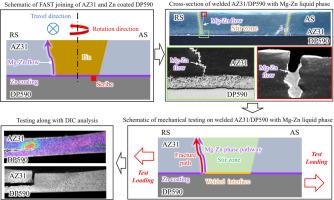镁与镀锌钢快速连接时的液态金属脆化
IF 13.8
1区 材料科学
Q1 METALLURGY & METALLURGICAL ENGINEERING
引用次数: 0
摘要
由于冶金不相容,将镁合金与钢连接是困难的。将锌(Zn)涂层涂在钢上,可以在焊接过程中形成薄的Mg-Zn共晶相层,从而促进牢固的结合。然而,在使用搅拌摩擦辅助划线技术(FAST)创建的接头中,这种Mg- zn共晶相层偶尔会从界面延伸到Mg片的表面。这种现象归因于液态Mg-Zn共晶相的形成,以及FAST工具诱导的独特物质流动。显微结构分析证实,Mg-Zn共晶相由α-Mg和Mg₂₁Zn₂₅金属间化合物组成。搭接剪切拉伸试验表明,当Mg-Zn共晶相迁移路径与搅拌区边界对齐时,导致接头强度降低,并沿共晶相路径过早断裂。这表明镁合金与镀锌钢在快速连接过程中发生了液态金属脆化。这些发现强调了在FAST焊接中控制工具特征和工艺参数以防止不同Mg/钢组件中LME相关故障的重要性。本文章由计算机程序翻译,如有差异,请以英文原文为准。

Liquid metal embrittlement during FAST joining of magnesium and galvanized steel
Joining magnesium (Mg) alloys to steel is difficult due to metallurgical incompatibility. Applying a zinc (Zn) coating to steel enables formation of a thin Mg-Zn eutectic phase layer during welding, which promotes strong bonding. However, in joints created with Friction-stir assisted scribe technology (FAST), this Mg-Zn eutectic phase layer occasionally extends from the interface to the surface of the Mg sheet. This phenomenon is attributed to the formation of a liquid-state Mg-Zn eutectic phase, coupled with the distinctive material flow induced by the FAST tool. Microstructural analysis confirmed that the Mg-Zn eutectic phase comprises α-Mg and the Mg₂₁Zn₂₅ intermetallic compound. Lap shear tensile tests revealed that when the Mg-Zn eutectic phase migration pathway aligned with the stir zone boundary, it led to reduced joint strength and premature fracture along the eutectic phase pathway. This indicates that liquid metal embrittlement (LME) occurred during FAST joining of Mg alloy and galvanized steel. These findings highlight the critical importance of controlling tool features and process parameters in FAST welding to prevent LME- related failures in dissimilar Mg/steel assemblies.
求助全文
通过发布文献求助,成功后即可免费获取论文全文。
去求助
来源期刊

Journal of Magnesium and Alloys
Engineering-Mechanics of Materials
CiteScore
20.20
自引率
14.80%
发文量
52
审稿时长
59 days
期刊介绍:
The Journal of Magnesium and Alloys serves as a global platform for both theoretical and experimental studies in magnesium science and engineering. It welcomes submissions investigating various scientific and engineering factors impacting the metallurgy, processing, microstructure, properties, and applications of magnesium and alloys. The journal covers all aspects of magnesium and alloy research, including raw materials, alloy casting, extrusion and deformation, corrosion and surface treatment, joining and machining, simulation and modeling, microstructure evolution and mechanical properties, new alloy development, magnesium-based composites, bio-materials and energy materials, applications, and recycling.
 求助内容:
求助内容: 应助结果提醒方式:
应助结果提醒方式:


